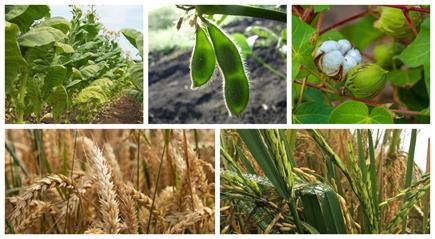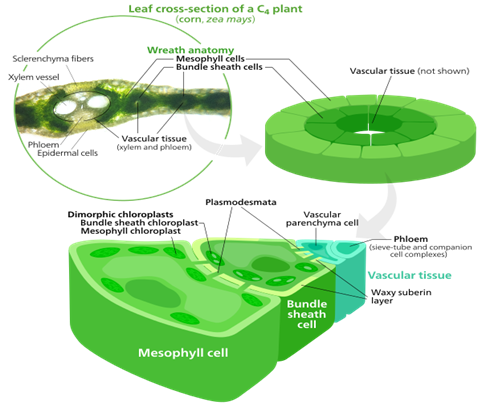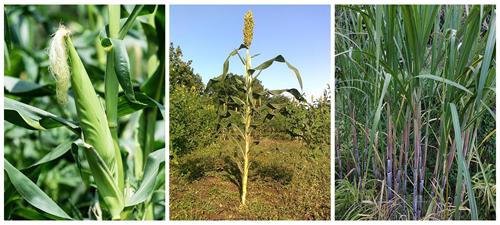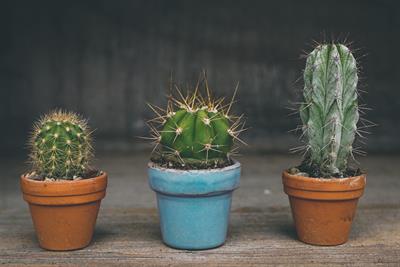
PUMPA - SMART LEARNING
எங்கள் ஆசிரியர்களுடன் 1-ஆன்-1 ஆலோசனை நேரத்தைப் பெறுங்கள். டாப்பர் ஆவதற்கு நாங்கள் பயிற்சி அளிப்போம்
Book Free DemoTo know about and plants, we should first know about photorespiration.
What is photorespiration?
- Photorespiration is a metabolic mechanism which occurs in photosynthetic organisms during the Calvin cycle.
- During this reaction, the organisms does not produce the chemical energy while releasing carbon dioxide and consuming oxygen.
- As a result, the growth rate of plants is reduced.
What are plants?
All the plants which do not have a photosynthetic adaptation to photorespiration are known as plants. They are identified by Calvin.
The reactions of Calvin cycle are observed in these plants. The Calvin cycle begins with an enzyme-fixing carbon dioxide, and plants that use this “standard” mode of carbon fixation solely are known as plants.
plants make up around \(95%\) of all plant species on the globe, including rice, wheat, soybeans, and all trees.

Examples of plants
plants are abundant in temperate conditions.
The photosynthetic efficiency of these plants is comparatively low due to their high rate of photorespiration.
What are plants?
These are the plants which have a photosynthetic adaptation to photorespiration.
These plants use an additional dark reaction pathway called the pathway and were discovered by M. D. Hatch and C. R. Slack in 1966. Hence, the cycle is also known as Hatch and Slack pathway.
What is Kranz anatomy?
The Calvin cycle and light-dependent reactions are physically segregated in plants.
The Calvin cycle occurs in specific cells around the leaf veins, and the light-dependent responses occur in the mesophyll cells (spongy tissue in the centre of the leaf). These cells are known as the bundle-sheath cells.
This anatomical setup is not observed in the plants. This is known as Kranz anatomy. Chloroplasts are found in their bundle-sheath cells.

Kranz anatomy of plant
Crabgrass, sugarcane, and corn are just a few examples of vascular plants that utilise the C4 pathway.

Examples of plants
plants grow in hot environments, but they are less prevalent in cooler ones. This is because the benefits of reduced photorespiration in hot conditions are likely to outweigh the ATP cost of transferring from the mesophyll cell to the bundle-sheath cell.
CAM plants:
Cacti and pineapples, adapted to arid settings, use the crassulacean acid metabolism (CAM) pathway to reduce photorespiration. Thus, these plants are referred to as CAM plants.
The name derives from the Crassulaceae plant family, which is where scientists initially found the pathway.

Crassulaceae plants
Unlike the and plants, the CAM plants separate the light-dependent reactions and the use of carbon dioxide in time.
The CAM plants open their stomata during the night, allowing to diffuse into the leaves.
During the day, the CAM plants perform photosynthesis without the opening of their stomata. This is because the organic acids are transported out of the vacuole and broken down to release , which enters the Calvin cycle and gets reduced to glucose.
Difference between and plants:
|
plants
|
plants
|
| These plants use Calvin cycle for the dark reactions of photosynthesis. | These plants use the Hatch and Slack pathway. |
| These are cool season plants that are found in the cold and wet areas. | These are warm season plants that are commonly seen in the dry areas. |
| plants make up around \(95%\) of all plant species on the globe. | They are about \(5%\) of the plant species. |
| Their leaves lack Kranz anatomy. | Their leaves show Kranz anatomy. |
| Their bundle sheath cells do not contain chloroplasts. | Their bundle sheath cells contain chloroplasts. |
| These plants can perform photosynthesis only when the stomata are open. | These plants can perform photosynthesis even when the stomata are closed. |
| Photorespiration rate is very high in these plants. | Photorespiration rate is vey low or mostly absent in these plants. |
| fixation is slow in these plants. | fixation is comparatively faster in these plants. |
| Carbon dioxide fixation occurs only once. | Carbon dioxide fixation occurs twice. |
| photosynthesis is the oldest and the most common. | photosynthesis is a recent phenomenon, emerging after photosynthesis. |
Reference:
https://pixabay.com/photos/tobacco-plant-smoking-tobacco-plant-1792070/
https://pixabay.com/photos/soy-soybean-nature-green-998566/
https://pixabay.com/photos/cotton-plant-green-nature-leaf-4654533/
https://pixabay.com/photos/wheat-plant-field-barley-rye-6191547/
https://pixabay.com/photos/paddy-rice-plant-grain-harvest-2913874/
https://pixabay.com/photos/maize-plant-corn-agriculture-food-5463051/
https://commons.wikimedia.org/wiki/File:Red_sugarcane_plant.jpg
https://commons.wikimedia.org/wiki/File:Sorghum_plant_Chinawal.jpg
https://commons.wikimedia.org/wiki/File:C4_photosynthesis_is_less_complicated.svg
https://pixabay.com/photos/cactus-prickly-desert-plant-spur-4161381/